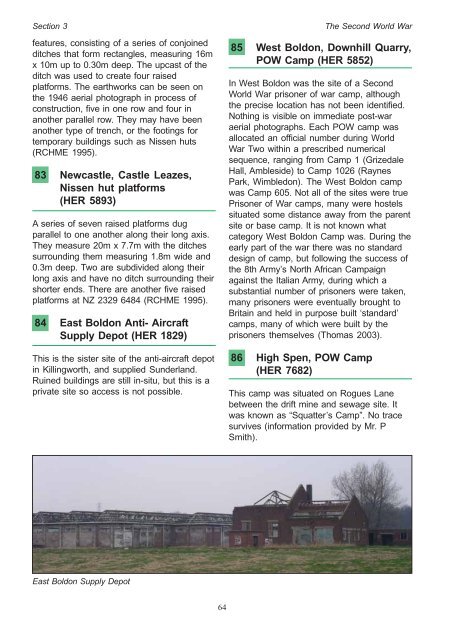TWENTIETH CENTURY DEFENCE SITES of TYNE and WEAR
TWENTIETH CENTURY DEFENCE SITES of TYNE and WEAR
TWENTIETH CENTURY DEFENCE SITES of TYNE and WEAR
Create successful ePaper yourself
Turn your PDF publications into a flip-book with our unique Google optimized e-Paper software.
Section 3 The Second World War<br />
features, consisting <strong>of</strong> a series <strong>of</strong> conjoined<br />
ditches that form rectangles, measuring 16m<br />
x 10m up to 0.30m deep. The upcast <strong>of</strong> the<br />
ditch was used to create four raised<br />
platforms. The earthworks can be seen on<br />
the 1946 aerial photograph in process <strong>of</strong><br />
construction, five in one row <strong>and</strong> four in<br />
another parallel row. They may have been<br />
another type <strong>of</strong> trench, or the footings for<br />
temporary buildings such as Nissen huts<br />
(RCHME 1995).<br />
83 Newcastle, Castle Leazes,<br />
Nissen hut platforms<br />
(HER 5893)<br />
A series <strong>of</strong> seven raised platforms dug<br />
parallel to one another along their long axis.<br />
They measure 20m x 7.7m with the ditches<br />
surrounding them measuring 1.8m wide <strong>and</strong><br />
0.3m deep. Two are subdivided along their<br />
long axis <strong>and</strong> have no ditch surrounding their<br />
shorter ends. There are another five raised<br />
platforms at NZ 2329 6484 (RCHME 1995).<br />
84 East Boldon Anti- Aircraft<br />
Supply Depot (HER 1829)<br />
This is the sister site <strong>of</strong> the anti-aircraft depot<br />
in Killingworth, <strong>and</strong> supplied Sunderl<strong>and</strong>.<br />
Ruined buildings are still in-situ, but this is a<br />
private site so access is not possible.<br />
East Boldon Supply Depot<br />
64<br />
85 West Boldon, Downhill Quarry,<br />
POW Camp (HER 5852)<br />
In West Boldon was the site <strong>of</strong> a Second<br />
World War prisoner <strong>of</strong> war camp, although<br />
the precise location has not been identified.<br />
Nothing is visible on immediate post-war<br />
aerial photographs. Each POW camp was<br />
allocated an <strong>of</strong>ficial number during World<br />
War Two within a prescribed numerical<br />
sequence, ranging from Camp 1 (Grizedale<br />
Hall, Ambleside) to Camp 1026 (Raynes<br />
Park, Wimbledon). The West Boldon camp<br />
was Camp 605. Not all <strong>of</strong> the sites were true<br />
Prisoner <strong>of</strong> War camps, many were hostels<br />
situated some distance away from the parent<br />
site or base camp. It is not known what<br />
category West Boldon Camp was. During the<br />
early part <strong>of</strong> the war there was no st<strong>and</strong>ard<br />
design <strong>of</strong> camp, but following the success <strong>of</strong><br />
the 8th Army’s North African Campaign<br />
against the Italian Army, during which a<br />
substantial number <strong>of</strong> prisoners were taken,<br />
many prisoners were eventually brought to<br />
Britain <strong>and</strong> held in purpose built ‘st<strong>and</strong>ard’<br />
camps, many <strong>of</strong> which were built by the<br />
prisoners themselves (Thomas 2003).<br />
86 High Spen, POW Camp<br />
(HER 7682)<br />
This camp was situated on Rogues Lane<br />
between the drift mine <strong>and</strong> sewage site. It<br />
was known as “Squatter’s Camp”. No trace<br />
survives (information provided by Mr. P<br />
Smith).

















